Corrective effect of different types of motor activity on natural longitudinal body growth
Фотографии:
ˑ:
The question of the corrective effect of the lag in the longitudinal measurements of one or both limbs in deficiency of the functional capacities of muscles of orthopedic patients on the body growth arises during the adaptation of the growth processes of schoolchildren to the environmental conditions [5]. The question of the impact of sports specialization on the body sizes is important when selecting children for classes in specialized sections and is not least for individuals who fall behind in growth and try to do something for their own appearance. That is why it is necessary to determine the grounds of the common provisions on the impact of certain sports activities on the rate of longitudinal growth of the body [4].
As stated in one of the well-known provisions of pathophysiology “The working cell doesn’t divide, and the dividing cell doesn’t work”. So, sports training, which stipulates for an additional increase of muscle strength, may be ineffective during rapid longitudinal growth of the body. Cell is divided only after the suppression of the functional evidences specific for this cell and destructions of appropriate intracellular structures. Growth is based on the translation processes, provoking protein synthesis, and differentiation is based on transcription processes, activation of the certain genome sectors, as a result the cell gets new molecules, coming in cytoplasm.
Forced workouts in the juvenile age can influence the rate of body growth, and earlier closure of methaepiphysial plates and a stop of the longitudinal body growth similar to the male sex hormones after a short phase of stimulation [1].
Children’s body growth is caused by genetic factors [11], is regulated by hormone system and resolved with the participation of many other body systems, including cardiovascular one. V.A. Kozlov et al. [2] confirmed that high arterial pressure speeds up the rate of longitudinal body growth. Brazilian researchers B. Horta et al. [7] concluded that both earlier and late growth spurt is related to the rise of the system arterial pressure. Hypertension during the natural body growth was proved to be an important link in the regulation of growth processes in children with perinatal pathology of development, with limb asymmetry in patients with consequences of poliomyelitis [6, 7, 14].
The purpose of the study was to analyze the impact of various sports on the rate of children’s growth and analyze the interrelation of the longitudinal body growth and the level of systolic blood pressure.
Material and methods. Anthropometry is the main research method of physical development. The length and weight were determined using the common anthropometric methods. Arterial pressure was measured by the Korotkov indirect method. The values of systolic and diastolic blood pressure were recorded after adaptation at rest in prone position.
The methods of variation statistics were used for the mathematical processing of the materials. The reliability of sample variance was assessed using the Student criterion. Thanks to the correlation analysis the type of the relationship between varying characteristics was determine, along with the strength and closeness of the relationship and its orientation.
As the surveyed groups differed in numbers in different types of analysis, the sample value is indicated specifically for each case. The researches were conducted at Kurgan specialized children’s sport school of Olympic reserve. The experimental group consisted of 40 male and 38 female acrobats aged 10 to 15, 20 male and 39 female volleyball players, 34 male and 20 female basketball players.
54 healthy schoolchildren, 85 18-29 year old students and soldiers and 93 women aged 30-90 years, were examined as a control group of non-athletes (Table 1).
Results and discussion. All the examined male athletes were from the same age group. The level of systolic and diastolic arterial pressure in acrobats and representatives of playing sports did not statistically differ (Table 1). Volleyball and basketball players had relatively bigger longitudinal measurements and weight. Acrobats were proved to have the direct correlation between the body growth rates and the level of systolic arterial pressure. This interconnection is less expressed in volleyball players. The closeness of this link depended on athletes’ qualification.
Table 1. The rates of male athletes (M±m)
|
Groups of respondents |
Age (years) |
Systolic AP (mm Hg) |
Diastolic AP (mm Hg) |
Weight (kg) |
Growth (cm) |
|
Acrobats |
|||||
|
No class (8) |
14 ±1 |
93 ±3 |
58 ±3 |
46 ±6 |
155 ±5 |
|
2nd class (14) |
13 ±1 |
107 ±4 |
62 ±2 |
50 ±3 |
157 ±3 |
|
1st class (18) |
13 ±1 |
100 ±1 |
65 ±2 |
43 ±3 |
151 ±2 |
|
Volleyball players |
|||||
|
No class (28) |
13 ±1 |
101 ±2 |
60 ±1 |
51 ±2 |
161 ±2 |
|
3rd class (14) |
14 ±1 |
105 ±2 |
64 ±2 |
56 ±3 |
168 ±2 |
|
1st-2nd class (12) |
13 ±1 |
102±3 |
62 ±2 |
56 ±3 |
168 ±2 |
Table 2. The rates of female athletes (M±m)
|
Groups of respondents |
Age (years) |
Systolic AP (mm Hg) |
Diastolic AP (mm Hg) |
Weight (kg) |
Growth (cm) |
|
Acrobats |
|||||
|
3rd class (12) |
13 ±0,4 |
94 ±4 |
58 ±2 |
43 ±2 |
151 ±3 |
|
2nd class (20) |
12,5 ±0,3 |
94 ±2 |
58 ±1 |
41 ±2 |
150 ±2 |
|
1st class (7) |
13,3 ±0,3 |
97 ±4 |
57 ±2 |
42 ±4 |
154 ±4 |
|
Volleyball and basketball players |
|||||
|
bask. w/class (18) |
12,8 ±0,2 |
99 ±2 |
60 ±1 |
46 ±2 |
158 ±2 |
|
Voll. w/c. (33) |
12,6 ±0,1 |
100 ±2 |
62 ±1 |
50 ±2 |
161 ±1* |
|
Voll. 2-3 c.(7) |
12,7 ±0,2 |
104 ±4 |
66 ±3 |
53 ±5 |
163 ±3 |
Girls engaged in acrobatics and playing sports with different qualifications were practically the same age (Table 2). Beginning female volleyball players weighed relatively more, were reliably higher and had unreliably higher arterial pressure. However, the allocated variance was determined not by the impact of sports occupations but by the character of the primary selection in appropriate sections. Longitudinal body sizes of girls in both age groups continued to increase and got closer to the mean height of 165 cm, specific for Kurgan women (Fig. 1).
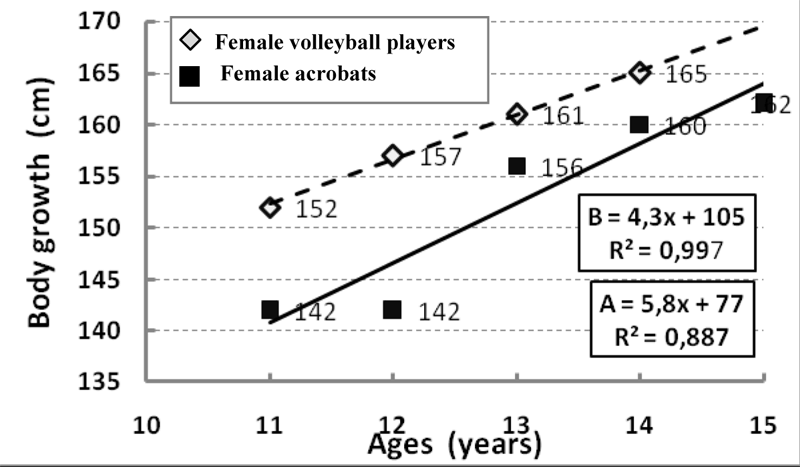
Fig. 1. Age dynamics of body growth of female volleyball players and acrobats.
At the same time the representatives of playing sports reached this limit earlier, but the acrobats had a faster rate of the body growth (5.7 cm per year vs. 4.3 cm per year in female volleyball and basketball players).
The correlation between the rates of systolic pressure arterial level and body growth is well expressed in female volleyball and basketball players and less expressed in acrobats. The rates didn’t have any dependence on the respondents’ age.
Athletes with the high level of systolic arterial pressure had a higher rate of the body growth. The interdependence of these rates was traced both among girls and boys (Fig. 2). According to the analysis of the blood pressure and body growth interdependence in different age groups of healthy non-athletes, the correlation coefficient between these rates is high among children, but the index is reversed after the end of the natural longitudinal growth of the body (Table 3). Such a type of the interdependence of arterial pressure and body growth rates is not accidental. Heart, ensuring the blood transport function, maintains the hydraulic body skeleton, which is essential for the growth of bones. This function changes after the period of natural longitudinal growth of the body. The allocated after the end of the body’s longitudinal growth reverse correlation of the level of systolic arterial pressure and body size can give an answer to the question which has caused the denial of the role of arterial pressure in the regulation of growth over the decades, "Why do mostly hypertensives have hypersthenic body build and are relatively small?"
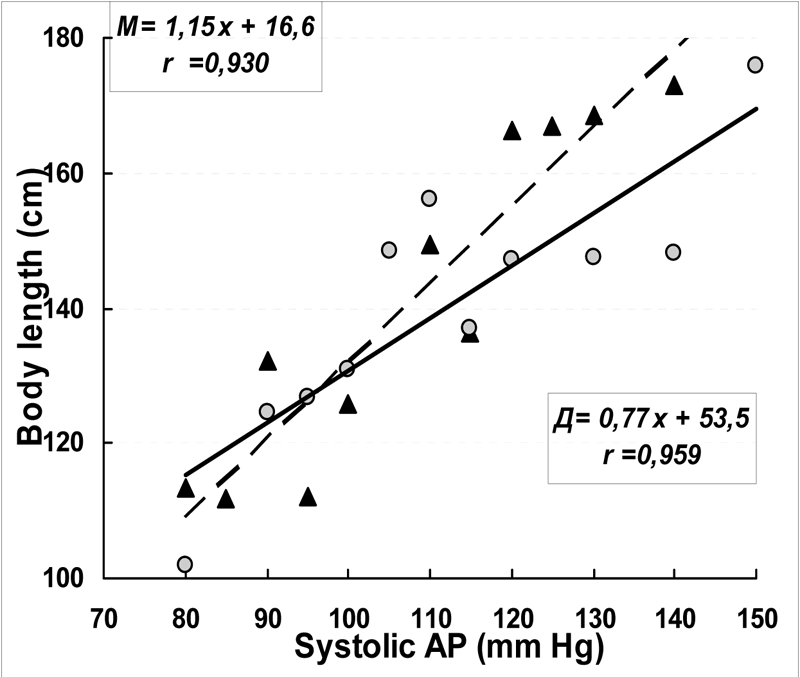
Fig. 2. Interdependence of longitudinal body size and systolic arterial pressure level in male and female athletes
The dynamics of the index of the correlation of systolic arterial pressure and longitudinal body size is illustrated in the graph (Fig. 3). The correlation coefficient of the respondents under the age of 15 is high, which indicates to the increase of longitudinal sizes with the rise of blood pressure level in children with the age. As soon as the period of the natural body growth in length ends, the positive correlation interdependence of the studied parameters changes its index to negative. The disturbance of this inversion due to extraordinary factors of impact can lead to juvenile hypertension development.
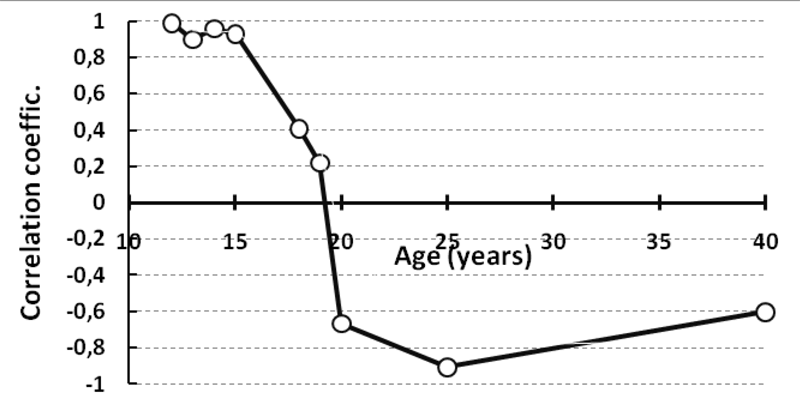
Fig. 3. Age dynamics of the correlation coefficient of systolic arterial pressure and longitudinal sizes
As opposed to the children not doing sports with the correlation coefficient between arterial pressure and body growth rates more than 0,9, this coefficient is reduced and unreliable in young athletes (0,1-0,3). Proceeding from the analysis of the interdependence of the studied indices in athletes of different groups, the coefficient does not depend on the respondents’ sex. The closeness of the correlation in young volleyball players increases with sports qualification (Fig. 4). The value reaches the reliable level in the athletes of the 1st junior class. Consequently, sport activities followed by the additional release of hormones, including somatotrophic hormone, which stimulates body growth, are not bad for the process of natural increase in longitudinal sizes only in elite athletes.
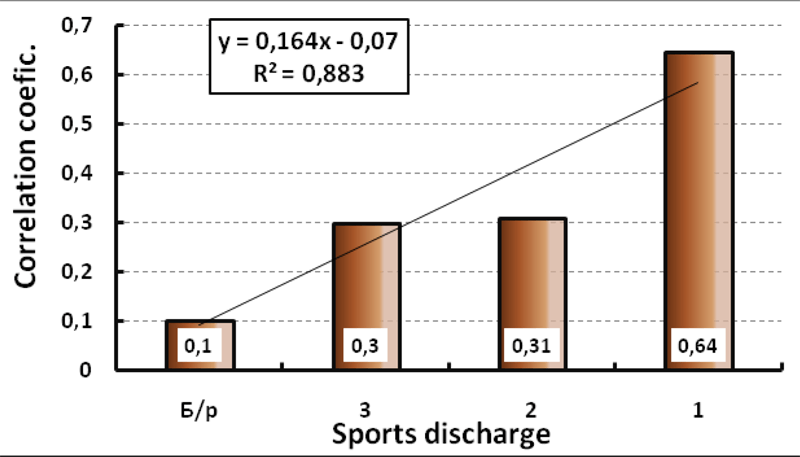
Fig. 4. Interdependence of arterial pressure and longitudinal body sizes rates in volleyball players of different qualifications
A completely different picture of the correlation of the interdependence of longitudinal sizes and systolic arterial pressure on the level of sports qualification can be observed in young acrobats (Fig. 5). Beginning athletes maintain the reliable interdependence of these rates. But it disappears with the rise of sport qualification. A similar dynamics of the coefficient value is observed in non-athletes when the natural longitudinal body growth is finished. Proceeding from the analysis of the age dynamics of the body growth in acrobats, the growth rate is only 4 cm a year for the 1st junior class, at 50% and 60% for the 2nd and the 3rd classes respectively (Fig.6). Consequently, we can conclude that there is suppressed effect of sport activities on the rate of longitudinal body growth.
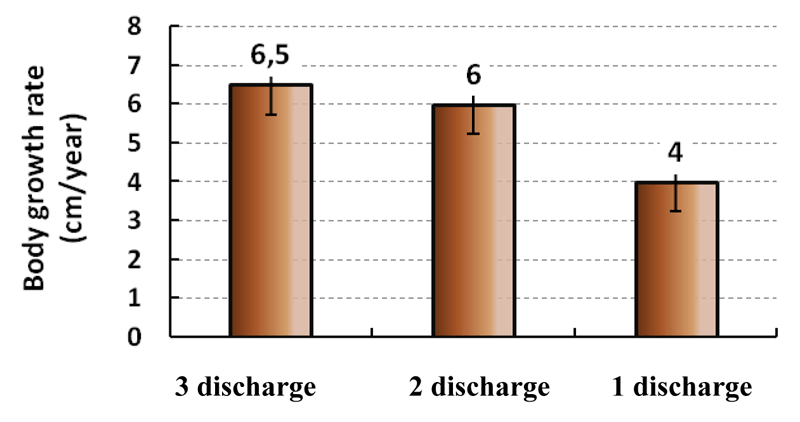
Fig. 5. The correlation coefficient of the interdependence of systolic arterial pressure and body growth in juvenile acrobats of different sport qualifications
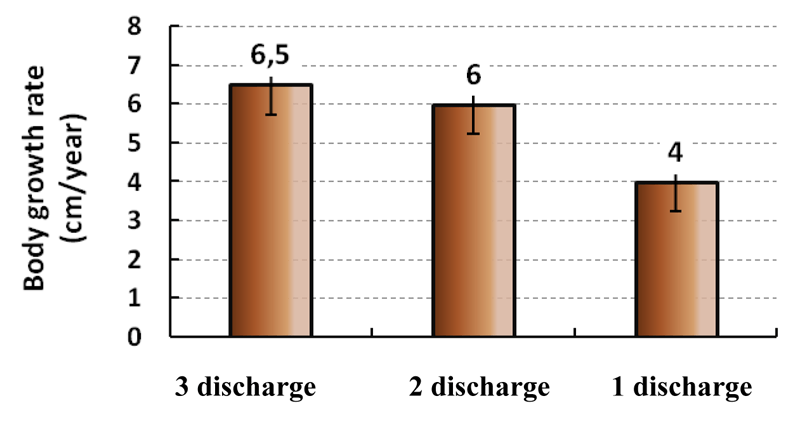
Fig. 6. Dependence of the body growth rate on the level of their qualification
Based on the findings of the analysis of anthropometric indices of young athletes, we concluded that sports specialization in children is being largely chosen in view of the data of initial longitudinal body sizes. That is why basketball and volleyball players are higher than their coevals engaged in acrobatics. However, different rates of development are not taken into account as well as the fact that the majority of children reach standard body sizes typical for the residents of this region during further growth. The previously lagging in growth acrobats enter the period of overtaking body growth. The body size of low qualified basketball players and acrobats starts leveling. Many teenagers will be forced to leave sport because of the difficulties of adaptation to specific sport activity. The further increase of sports skills is possible only if the anthropometric characteristics of the body correspond to specific requirements for this sport. According to our studies, in such cases sport activities can have both stimulative and inhibitory influence on the growth rate of the body.
Consequently, the selection of young athletes should be conducted from the beginning not by body growth, but by the level of development of specific skills. As for prospects of the longitudinal body size changes, in this case it is advisable to focus on longitudinal body sizes of parents with known developed coefficients [13]. In addition, it is better to take into account the current growth rate of children. It is useful to examine the age arterial pressure dynamics in assessing the prospects of the growth rate. Our data on the correlation of arterial pressure and body sizes in young female athletes in the first approximation was paradoxical and did not fit into the concept that the closeness of the correlation reflects the body growth rate. In particular, the correlation coefficient of female basketball players was proved to be relatively low. The reason for this discrepancy is not the impropriety of the concept, but the degenerate nature of the respondents’ selection. Low qualified girls without ranks lacking body growth were eliminated from the selection. The same thing happened in the group of low qualified female acrobats with relatively big body sizes. Men's groups were more stable because boy’s deficient or excess body growth is easier to compensate when developing specific sports skills.
Until now, the majority of researchers believe that arterial pressure and body size of children increase with age and independently of each other. However, the time embodied in age can not be the driving force of development. The correction mechanism of the growth rate of the body at the expense of the change in arterial pressure level is crucial in this issue. The increase in interstitial pressure, depending on the size of the filtration pressure, increasing both in the transmission of arterial pressure in the capillary network and in the difficulty of venous blood return can affect change in strain of distension of tissues.
The matters of the interdependence of the increase in venous, capillary pressure, capillary blood flow rate and natural growth are quite fully covered in the foreign sources. The growth of children is really stimulated by the increase of venous pressure provides in addition to the rise of arterial pressure. [10]. Many facts prove the influence on the growth of organs and tissues of increase of interstitial fluid pressure in inherent and acquired arteriovenous anastomoses, vascular tumors and tumors of other tissues [9,12].
The scientific novelty of this work is in the attempt to prove that the cardiovascular system does not act only the transport function in the body, but a number of others, including those involved in the implementation of the growth processes that must be considered in qualification of young athletes.
Conclusions
- The longitudinal measurements of the body are bigger in young athletes, engaged in volleyball and basketball, rather than acrobats by 6,6%, and weight - by 18%.
- The high correlation (more than 0.9) of systolic arterial pressure and body growth was detected in children and adolescents not involved in sport.
- The correlation of blood pressure and body growth reduces and becomes negative in acrobats of the 1st class with the rise of sport qualification.
- The correlation gets closer with the rise of sports skills in young volleyball and basketball players.
References
- Bunak, V.V. Regularities of relative growth as a main factor of forming in the late postembryonic ontogeny // Constitution and sports. Thes. Arkhangelsk. 1961. Ed. 2 – P. 3-16. (In Russian)
- Kozlov, B.A., Kozlova, A.K. About dependence of age changes of blood pressure in teenagers on the growth in length //Pediatrics. 1978. № 8. – P. 34-35. (In Russian)
- Nikityuk, B.A. Interactive approaches in age and sports anthropology. M. In-te psych. RAS, 1999. – 219 P. (In Russian)
- Okishev, I.V. About the tendency of body size increase and the influence of this process on the adolescent cardiovascular system // Author's abstract. Candidate. Biol. Science. Chelyabinsk. 1973. – 20 P. (In Russian)
- Schurov, V.A., Kudrin, B.I., Dyakin, V.M., Vlasova, S.S. Growth peculiarities of children and adolescents with achondroplasia // Pediatrics, 1982. № 11. – P. 61-62. (In Russian)
- Schurov, V.A., Schencov, V.I., Ivanova, T.I., Shatokhin, V.D. Hypertension and longitudinal growth in children and adolescents with musculoskeletal diseases //Pediatrics, 1985. № 3. –P. 40-42. (In Russian)
- Schurov, V.A., Sazonova, N.V. Growth peculiarities of children with perinatal pathology of the central nervous system and pathology of the lower extremities. //Genius of orthopedics, 2002. № 2. –P. 120-122. (In Russian)
- Horta, B.L., Barros, F.C., Victora, C.G., Cole, T.J. Early and late growth and blood pressure in adolescence //J. Epidemiol. and community Health, 2003.V. 57. No 3. –P. 226-230.
- Kahn, H.S., Bain, R.P., Smith, B.P. Interpretation of children’s blood pressure using physiologic Height correction //J. of chronic Diseases, 1986. V. 39. No 7. –P. 521-533.
- Kelly, P.J., Bronk, J.T. Venous pressure and Bone formation //Microvascular Research, 1990. V. 39. No 3. –P. 364-375.
- Tanner, J.M., Healy, M.J., Ljckhard, J.D. et al. Aberdeen Growth study // Arch. Dis. Child, 1956. V. 31. No 3. –P. 372-381.
- Voors, A.W., Webber, L.S., Frerichs, R.R., Berenson, G.S. Body Height and body Mass as determinants of basal blood pressure in children – The Bogalusa Heart Study //Am. J. of Epidemiology, 1977. V. 106. No 2. –P. 101-108.
- Weech, A.M. Signposts on highway of growth //Am. J. Dis. Child, 1954. V. 88. No 3 –P. 452.
- Welner, A., Yosipovich, Z.H., Groen, J.J. Ellevated blood pressure in children and adolescents with residual paralysis and deformities from poliomyelitis and other crippling diseases //J. Chronic Diseases (Eng), 1966. V. 19. No 11-12. –P. 1157-1164.
Author's contacts:
Kuchin Roman kuchin_r@mail.ru
Schurov Vladimir shchurovland@mail.ru
Kuznecov Alexander kuznecoy@kgsu.ru

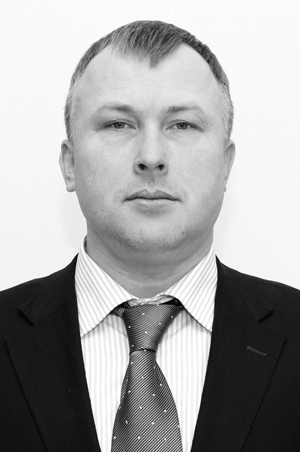

 Журнал "THEORY AND PRACTICE
Журнал "THEORY AND PRACTICE